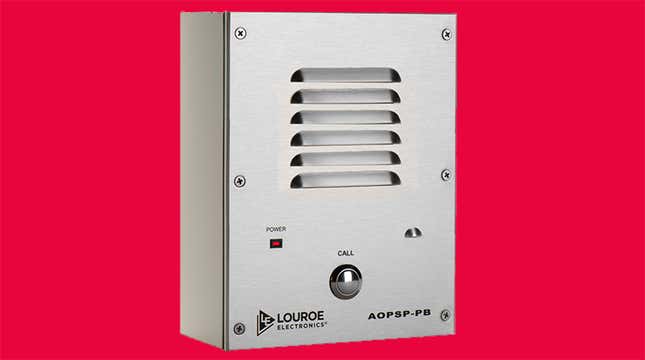
The deeply founded fear of school shootings is being capitalized on by tech companies shilling their surveillance systems that can purportedly detect the threat of violence. But according to a recent report, these systems are still far from dependable.
ProPublica published a report on Tuesday that tested Sound Intelligence’s aggression detector, one of the audio surveillance systems schools have been adopting as a safety measure. The software uses a machine learning algorithm to learn to identify “aggression in a person’s voice” as well as “sound patterns associated with duress, anger or fear,” according to the company site. Whenever the sounds in a room exceed a user-determined threshold for a certain period of time, an alert is sent to the school’s surveillance system, or an administrator can receive a text message identifying the microphone that’s been triggered.
According to the report, when ProPublica tested a Louroe microphone, which is equipped with Sound Intelligence’s aggression detection software, in a large space, the device failed to identify “many screams” but was set off by people cheering for an incoming pizza delivery as well as laughing. It was also triggered by students shouting Pictionary guesses, such as “A fireman!” and “Lucifer!”
“Nowadays, video surveillance is not enough and many schools are leveraging the dynamic duo of audio and video surveillance in helping to keep their students, staff, and campuses safe,” a voiceover states in a Louroe Electronics video targeted at education institutions. “Audio is a great tool that provides additional monitoring and easily integrates with existing cameras and visitor management systems.”
But aside from just the failures discovered through ProPublica’s own testing of the audio surveillance equipment, schools also reported their own mishaps with the devices, which reportedly cost about $1,000 for one aggression-detecting microphone. A student reportedly triggered a device at Staples Pathways Academy in Connecticut when she coughed. Pinecrest Academy Horizon in Nevada has two Louroe microphones installed at its campus. They’ve reportedly been triggered by locker door slams. And at Rock Hill Schools in South Carolina, its audio surveillance system, which instead is built into Axis cameras, which costs tens of thousands of dollars, was triggered by students loudly telling their friends happy birthday.
These surveillance systems equipped with Sound Intelligence software are not unique to schools—they have also been deployed across institutions such as hospitals, banks, retail stores, and prisons. The Valley Hospital in New Jersey is ending its three-year pilot program of the system, which is installed in “high risk” areas because it mistook people speaking loudly as well as loud innocuous cafeteria noises as signs of aggression, yet failed to identify a man causing a scene requiring six security officers.
But ProPublica’s report, as well as plenty of other reports in recent years, indicate that these powerful surveillance systems are really only dependable in their ability to constantly collect data on those it’s monitoring, but have yet to prove that they are an effective tool to both identify and prevent truly harmful situations. And yet, schools are spending millions of dollars on an unsettling spectrum of surveillance technology in the absence of any proof that they are reliable and free from bias.
“Schools are justified in thinking about safety, both in terms of gun violence and other possible hazards,” Rachel Levinson-Waldman, senior counsel at the Brennan Center for Justice, told Gizmodo last year. “At the same time, these technologies do not exist in a vacuum; we know, for instance, that facial recognition is less accurate for women and people of color, and also that school discipline is imposed more harshly on children of color.”
And in the specific instance of devices that supposedly can detect aggression, even if they were successful, pinpointing hostile behavior isn’t a reliable way to determine whether someone might be inclined to bring a gun to campus and open fire.
“I wouldn’t claim that we could prevent a crazy loony from shooting people,” Sound Intelligence CEO Derek van der Vorst told ProPublica.